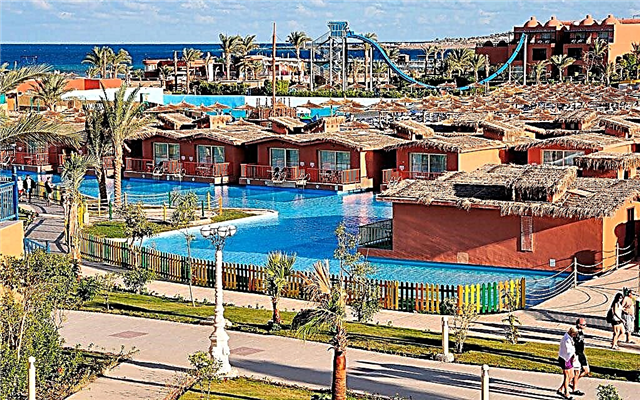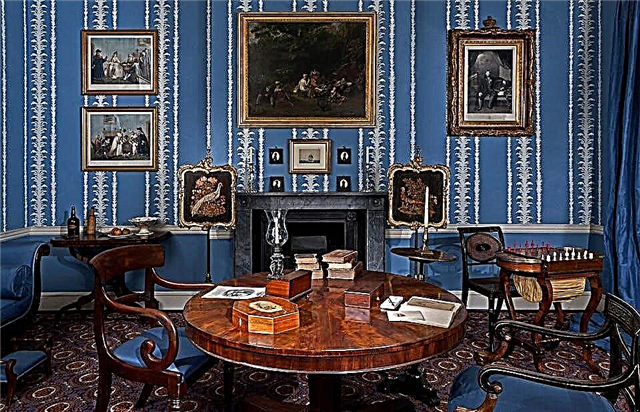Address: Russia, Yaroslavl region, Rostov Veliky, pl. Sovetskaya, 14
Foundation date: about 1390-1394
Main attractions: Church of the Nativity of the Blessed Virgin Mary, Church of the Tikhvin Icon of the Mother of God, wooden bell tower, Church of St. Nicholas the Wonderworker on Podozerie (attributed)
Coordinates: 57 ° 11'05.5 "N 39 ° 25'16.0" E
Content:
Monasteries of Rostov the Great
The Rostov Rozhdestvensky monastery in the past was called the Maiden. It takes only five minutes to walk from the noisy Kremlin to get to a place where peace and quiet seem to have settled forever. Monastic life was also distinguished by its special leisurely and measured nature in former times. And no matter what trials fell to her lot, the monastery was always revived. This is the case today, when the ancient monastic temples are being restored by the efforts of many people.

Rozhdestvensky monastery from a bird's eye view
The history of the Rozhdestvensky monastery
The monastery was founded in the XIV century, according to some sources - in 1391. It arose inside the fortified city rampart that protected the city from enemies. The main role in the creation of the new monastery was played by the native nephew and beloved disciple of Sergius of Radonezh, Saint Theodore, who at that time was an archbishop in Rostov.
In addition to his diplomatic and translation gift, Fedor was a famous icon painter of his time. He personally painted a copy of the famous icon of the Tikhvin Mother of God and created a picturesque image of the Most Holy Theotokos, and donated both icons to the new monastery. Later, rich frames were made for these revered icons, which adorned pearls and precious stones. But today, unfortunately, the fate of these ancient images is not known.
From the moment of its foundation until the second half of the 18th century, the monastery received generous donations from the Russian tsars. After the church reform, carried out in 1764, the monastery was subsidized by the state and received income from its own economic activities. These funds allowed the monastery to revive after major fires or devastation that occurred during the Time of Troubles.
In the 60s of the 17th century, 25 nuns and the abbess lived in the monastery. At the end of the 17th century, the first brick Christmas church was built here and four side-chapels were consecrated in it. On the upper floor - in honor of the Nativity of the Mother of God and the Life-Giving Trinity, and on the lower - in honor of Dmitry of Rostov and Alexei, the man of God. The construction of stone churches in those days began by decree of Empress Catherine II and affected the entire central part of Rostov.

Rozhdestvensky monastery general view
A century later, a new refectory Tikhvin church, brick cells, living rooms and a rector's building appeared in the monastery. And in the 10s of the XIX century, the territory of the monastery, previously fenced with a wooden fence cut into a cage, was surrounded by a brick wall, which was decorated with six small decorative towers.
In former times, the property of the monastery was considered an island on Lake Nero, which is visible from the monastery itself. It was formerly called Rozhdestvensky and was used for hay meadows. Both living rooms also brought income to the monastery. In addition to temples, a stable, a cowshed, a barn and a large cellar were located on its territory. And in the center of the courtyard is a pond.
The monastery also received a large profit from the labor of nuns-needlewomen. Among them were many craftswomen who knew the secrets of sewing and gold sewing. They could make skillful embroidery on canvas, as well as satin stitch using multicolored threads made of wool and silk. A dowry could be bought at the monastery, which included embroidered bed linen and clothing. The nuns taught their skills to orphan girls living in the monastery shelter.
In the middle of the 19th century, the first parish school in Rostov, and in the entire district, was opened at the monastery. It began with a literacy school for girls from poor peasant families. For about half a century, training sessions were held in apartments, but in 1903, a brick house was built next to the monastery with monastic funds, intended specifically for a parish school. Now it houses the local registry office. The school was supported by monastic funds and used a library collected by the nuns.

Fragment of the fence against the background of the Church of the Nativity of the Blessed Virgin Mary
At the end of the 19th century, more than two hundred nuns and Abbess Maria (Chistovskaya) lived in the monastery. In 1894, they had the honor to receive within the walls of the monastery a distinguished guest - John of Kronstadt.
With the advent of Soviet power, the life of the monastery changed. In 1926 it was liquidated. The monastic cells were inhabited by city dwellers. The Rostov archive was placed in the main Nativity church, which was here until 1989. A library was built in the Tikhvin Church, which still exists there. In the 1960s, the bell tower and the heads of the Tikhvin Church were dismantled.
In 1997, the monastery was returned to the believers. He was at this time in a very neglected state. Five nuns and an abbess from the Tolgotsky monastery settled here. And the years of difficult restoration and restoration work began, which continue to this day. In 1999, the church of Nicholas on Podozerie, located to the south-west of it, was attributed to the monastery. Monastic services are now being held in this temple.

Fragment of the fence with the Southwest Tower
Architectural monuments inside the Rozhdestvensky Monastery
The very first buildings of the monastery were made of wood and have not survived to this day. The oldest building that can be seen in the monastery today is the Nativity Cathedral. It appeared here at the end of the 17th century during the time of Metropolitan Jonah III of Rostov (Sysoevich). Researchers believe that most likely the same architects who erected the churches of the Rostov Kremlin were invited for its construction. The construction took a long time - until 1702. And the interior painting of the walls was done even later - in 1715. Its main theme was the glorification of the Mother of God. In 1883, this painting was renewed.
The two-story cathedral is very spacious inside. It has one chapter above the main building and one above a small aisle. An extensive refectory adjoins the temple, during the construction of which a rare architectural solution was applied. Its vaults are supported by a single pillar in the middle of the building.
The two-tiered hipped-roof bell tower of this temple, built in 1817, has not survived to this day. Instead, there is a small wooden bell, installed in 2001. But the clock from the old bell tower survived. They were bought with money allocated by a merchant widow from Rostov E.D. Malgina. Now this clock can be seen on the city fire tower, which, by the way, in the Soviet years, was also converted from the former high bell tower of the Exaltation of the Church.
In the forties of the XIX century, a warm church dedicated to the Tikhvin Icon of the Mother of God was erected in the monastery. She became the last stone building of the monastery. Today this temple can be seen stripped of all its five chapters, in a badly disfigured form.

Church of St. Nicholas the Wonderworker on Podozerie (attached temple)
The northern wall of the monastery faces Sovetskaya Square. Previously it was called Rozhdestvenskaya. Western - looks at Second Tolstovsky Lane. South and east - for the most part adjoin the corner of the fortress earthen rampart, built during the reign of Mikhail Fedorovich (1632). The complex of buildings of the Rozhdestvensky Monastery is recognized as an architectural monument of the 17th-19th centuries and is protected by the state.And in the museum collection of the Rostov Kremlin, you can see the beautifully embroidered shroud "The Nativity of the Most Holy Theotokos" - one of the surviving treasures of the Nativity monastery. It was made in 1664 by skilled embroiderers from a workshop owned by Princess M.M. Lugovskoy.
The current state and working hours of the Rozhdestvensky monastery
The current nunnery belongs to the Yaroslavl diocese. You can freely enter its territory. Daily services are held in the monastery church of Nicholas on Podozerie.
The state of the Nativity Cathedral can still be assessed as emergency. But restoration work began in it. The abbess's chambers have been restored, and a beautiful flower garden has been laid out near the Nikolsky Church.
How to get to the Rozhdestvensky monastery
The monastery is located on Sovetskaya Square, 14, 5 min. course to the east from the Rostov Kremlin.
By car. The federal highway M8, connecting Moscow and Arkhangelsk, leads to Rostov. From the capital to the city - 220 km, and from Yaroslavl - 55 km. Upon reaching the railway station, you need to turn towards the city center. From here, go along Lunacharsky Street, and, before reaching the Rostov Kremlin, turn left.

Wooden bell tower against the background of the Church of the Tikhvin Icon of the Mother of God
On your own by train and bus. It is convenient to get from the capital to Rostov by Yaroslavl express trains. They depart twice a day - at 8.20 and 16.20. The train goes to Rostov for about three hours. And from the city center you can get to the monastery by regular buses, minibuses, or in 20-25 minutes. walk.










